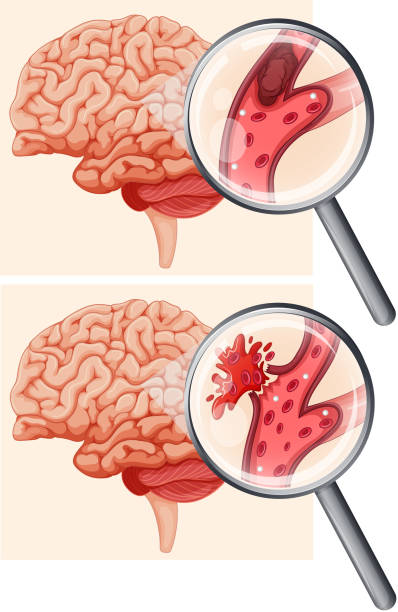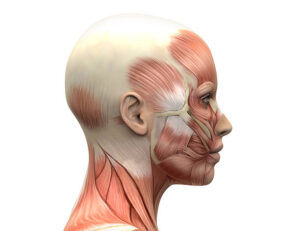
Human Brain and Hemorrhagic Stroke illustration
What are the symptoms of a stroke?
Adelekan Oluwaseun Ojo.
Different areas of the brain control different abilities, so stroke symptoms depend on the affected area. An example of this is a stroke that affects Broca’s area, a part of the brain that controls how you use muscles in your face and mouth to speak. That’s why some people slur their words or have trouble speaking when they have a stroke.
The symptoms of stroke can involve one or more of the following:
– One-sided weakness or paralysis.
– Aphasia (difficulty with or loss of speaking ability).
– Slurred or garbled speaking (dysarthria).
– Loss of muscle control on one side of your face.
– Sudden loss — either partial or total — of one or more senses (vision, hearing, smell, taste and touch).
– Blurred or double vision (diplopia).
– Loss of coordination or clumsiness (ataxia).
– Dizziness or vertigo.
– Nausea and vomiting.
– Neck stiffness.
– Emotional instability and personality changes.
– Confusion or agitation.
– Seizures.
– Memory loss (amnesia).
– Headaches (usually sudden and severe).
– Passing out or fainting.
– Coma.
Transient ischemic attack (TIA).
A transient ischemic attack (TIA) — sometimes called a “mini-stroke” — is like a stroke, but the effects are temporary. These are often warning signs that a person has a very high risk of having a true stroke in the near future. Because of that, a person who has a TIA needs emergency medical care as soon as possible.
What causes stroke?
Ischemic strokes and hemorrhagic strokes can happen for many reasons. Ischemic strokes usually happen because of blood clots. These can happen for various reasons, such as:
– Atherosclerosis.
– Clotting disorders.
– Atrial fibrillation (especially when it happens due to sleep apnea).
– Heart defects (atrial septal defect or ventricular septal defect).
– Microvascular ischemic disease (which can block smaller blood vessels in your brain).
Hemorrhagic strokes can happen for several reasons also, including:
– High blood pressure, especially when you have it for a long time, when it’s very high, or both.
– Brain aneurysms can sometimes lead to hemorrhagic strokes.
– Brain tumors (including cancer).
– Diseases that weaken or cause unusual changes in blood vessels in your brain, such as moyamoya disease.
Related conditions
Several other conditions and factors can contribute to a person’s stroke risk. These include:
– Alcohol use disorder.
– High blood pressure (this can play a role in all types of strokes, not just hemorrhagic ones because it can contribute to blood vessel damage that makes a stroke more likely).
– High cholesterol (hyperlipidemia).
– Migraine headaches (they can have symptoms similar to a stroke, and people with migraines — especially migraines with auras — also have a higher risk of stroke at some point in their life).
– Type 2 diabetes.
– Smoking and other forms of tobacco use (including vaping and smokeless tobacco).
– Drug misuse (including prescription and non-prescription drugs).
Is it contagious?
Strokes aren’t contagious and you can’t pass them to or get them from other people.
How are strokes treated?
Treating a stroke depends on many different factors. The most important factor in determining treatment is what kind of stroke a person has.
Ischemic: With ischemic strokes, the top priority is restoring circulation to affected brain areas. If this happens fast enough, it’s sometimes possible to prevent permanent damage or at least limit a stroke’s severity. Restoring circulation usually involves a certain medication type called thrombolytics, but may also involve a catheterization procedure.
Hemorrhagic: With hemorrhagic strokes, treatment depends on the location and severity of the bleeding. Reducing blood pressure is often the top priority because this will reduce the amount of bleeding and keep it from getting worse. Another treatment option is to improve clotting so the bleeding will stop. Surgery is sometimes necessary to relieve pressure on your brain from accumulated blood.
What medications or treatments are used?
The medications and treatments used vary depending on the type of stroke and how soon a person receives treatment after the stroke. There are also long-term treatments for stroke. These happen in the days and months after emergency treatment deals with a stroke’s immediate threat.
Overall, your healthcare provider is the best person to tell you what kind of treatment(s) they recommend. They can tailor the information they provide to your specific case, including your medical history, personal circumstances and more.
Some examples of treatments for stroke are as follows:
Thrombolytic drugs
Thrombolytic drugs (their name is a combination of the Greek words “thrombus,” which means “clot,” and “lysis,” which means “loosening/dissolving”) are an option within the first three hours after stroke symptoms start. These medications dissolve existing clots. But they’re only an option within that three- to four-and-a-half hour time frame because after that, they increase the risk of dangerous bleeding complications.
Mechanical thrombectomy
In some cases, especially ones where thrombolytic drugs aren’t an option, a catheterization procedure known as mechanical thrombectomy is an option. Thrombectomy procedures are also time-sensitive, and the best window for these procedures is within 24 hours after symptoms start. This procedure involves inserting a catheter (tube-like) device into a major blood vessel and steering it up to the clot in your brain. Once there, the catheter has a tool at its tip that can remove the clot.
Blood pressure management
Because high blood pressure is usually why hemorrhagic strokes happen, lowering blood pressure is a key part of treating it . Lowering blood pressure limits bleeding and makes it easier for clotting to seal the damaged blood vessel.
Clotting support
Your body’s clotting ability relies on a process called hemostasis to stop bleeding and repair injuries. Supporting hemostasis involves infusion of medications or blood factors that make it easier for clotting to happen. Examples include vitamin K therapy, prothrombin or clotting factor infusions, and more. This treatment is most common with hemorrhagic strokes, and can help control bleeding (especially for people who take blood-thinning medications).
Surgery
In some cases, surgery is necessary to relieve the pressure on your brain. This is especially true with subarachnoid hemorrhages, which are easier to reach because they’re on the outer surface of your brain.
Supportive treatments and other methods
There are several other ways that stroke treatment can happen. Some of these treatments are supportive directly, while others help avoid complications. Your healthcare provider can tell you more about these other treatments and which ones they recommend and why.
Stroke rehabilitation
One of the most important ways to treat stroke is to help a person recover or adapt to the changes in their brain. That’s especially true when it comes to helping them regain abilities they had before the stroke. Stroke rehabilitation is a major part of recovery for most people who have a stroke. That rehabilitation can take many forms, including:
– Speech therapy: This can help you regain language and speaking abilities and improve your ability to control muscles that help you breathe, eat, drink and swallow.
– Physical therapy: This can help you improve or regain the ability to use your hands, arms, feet and legs. This can also help with balance issues, muscle weakness and more.
– Occupational therapy: This can help retrain your brain so you can go about your activities of daily life. This therapy is especially helpful with improving precise hand movements and muscle control.
– Cognitive therapy: This can be helpful if you’re having memory problems. It can also help if you have difficulty with activities that require focus or concentration that you could do before.
Other therapies are possible, depending on your case and circumstances. Your healthcare provider is the best person to tell you what kind of treatments can benefit you.
Complications/side effects of the treatment
The side effects of stroke treatments depend greatly on the type of stroke, the treatments used, your medical history and more. Your healthcare provider can tell you more about the side effects you can or should expect and what you can do to manage or even prevent them.
How can I take care of myself or manage the symptoms?
A stroke is a life-threatening medical emergency, and you shouldn’t try to self-diagnose or self-treat it. If you have — or someone with you has — stroke symptoms, you should immediately call your health care provider. The longer it takes for stroke treatment to begin, the greater the risk of permanent brain damage or death.
How can I reduce my risk of having a stroke or prevent them entirely?
There are many things you can do to reduce your risk of having a stroke. While this doesn’t mean you can prevent a stroke, it can lower your risk. Actions you can take include:
Improve your lifestyle. Eating a healthy diet and adding exercise to your daily routine can improve your health. You should also make sure to get enough sleep (the recommended amount is seven to eight hours).
Avoid risky lifestyle choices or make changes to your behaviors. Smoking and tobacco use, including vaping, recreational drug use or prescription drug misuse, and alcohol misuse can all increase your risk of having a stroke. It’s important to stop these or never start them. If you struggle with any of these, talking to your healthcare provider is important. Your provider can offer you guidance and resources that can help you change your lifestyle to avoid these behaviors.
Manage your health conditions and risk factors. There are several conditions, such as obesity, abnormal heart rhythms, sleep apnea, high blood pressure, Type 2 diabetes or high cholesterol, which can increase your risk of having an ischemic stroke. If you have one or more of these conditions, it’s very important that you do what you can to manage them, especially by taking medications — such as blood thinners — as prescribed by your provider. Doing that earlier in life can you avoid severe stroke-related problems later in life.
See your primary care provider for a checkup or wellness visit annually. Yearly wellness visits can detect health problems — especially ones that contribute to having a stroke — long before you feel any symptoms.
Is there anything I shouldn’t eat or drink with this condition?
If you’re at risk for any kind of stroke, your healthcare provider may recommend changing your diet to avoid increases in blood pressure. Examples of this include:
Beverages that contain caffeine, such as coffee, tea, soft drinks, etc.
Foods that contain a lot of salt or sodium, which can increase blood pressure.
Foods that are high in saturated fats, such as fried foods, etc.
Alcohol or recreational stimulant drugs (cocaine, amphetamines/methamphetamine, etc.).
GOOD NEWS…
For over 4 years now, JIGSIMUR herbal health drink, a health drink produced from the sap found in Aloe Ferox plant has proven to be a very effective natural solution to strike cases of different levels.
JIGSIMUR corrects the body hormones, repairs the damaged cells which caused the lack of proper blood flow or blockage and adjusts all organs connected to the affected part of the brain. Once all repairs and corrections are done, blood will flow as should, all blockages are open and all is corrected. There will then be proper activities of blood flow to that affected part of the brain, there by leading to a healthy life experience.
NOTE: The treatment of stroke cases with Jigsimur will require a long time use of several bottles before desired result is achieved. The repairs of the damaged cells may take a while, so also the correction of all connected body organs. Jigsimur starts the curative process by detoxifying of all toxins in the entire body. On the average treatment of stroke may require consistent usage of Jigsimur for about 6 months.
It is advisable to add Jigsimur to your lifestyle for prevention of stroke or any other health issue that may generate in future.
They say… PREVENTION IS BETTER THAN CURE!
……….…………… Adelekan Oluwaseun Ojo, is a counseling psychologist, and a business & health consultant with Jigsimur Zdex Int’l, a company which is into the production and distribution of Jigsimur herbal health drink, a natural curative and preventive herbal medicine from South Africa.








